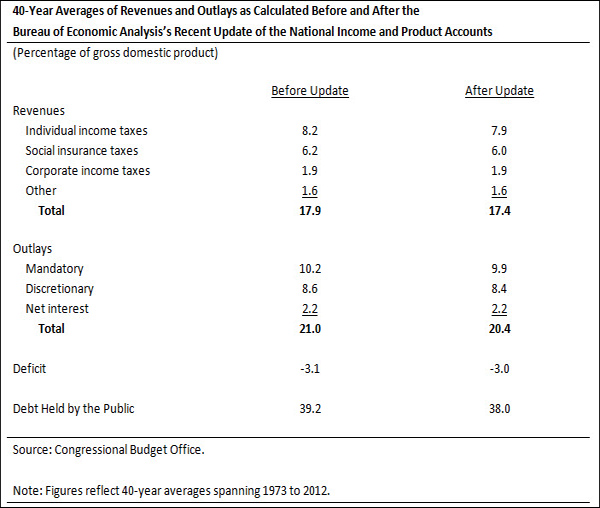On July 31, the Bureau of Economic Analysis (BEA) of the Department of Commerce released a comprehensive revision of the entire history of the national income and product accounts. The revision included improvements to the definitions, classifications, and methodologies used in the accounts as well as newly available and revised source data. The revision did not indicate any changes in broad economic trends or the general patterns of business cycles, but it did raise the figures for gross domestic product (GDP) in every year back to 1929. In 2012, for example, GDP was revised upward by $560 billion, or 3.5 percent. Most of the upward revision reflects BEA’s decisions to incorporate expenditures for research and development and to include entertainment, literary, and artistic originals as fixed investment.
As a result of those revisions, historical budget figures that are expressed as a percentage of GDP are now lower, although no changes have been made to the budget data (see the updated historical tables that we recently posted on CBO’s website). For example, the deficit of $1,087 billion recorded for fiscal year 2012 is unchanged, but that figure now represents 6.8 percent of GDP, in contrast to the previous assessment (using the prior data published by BEA) that the 2012 deficit represented 7.0 percent of GDP.
Accordingly, the 40-year averages of spending, revenues, deficits, and debt as percentages of GDP used by CBO as a basis of comparison for major budget categories have also dropped (see the table).
- The updated calculations affected the averages for revenues and outlays about equally: Under BEA’s revised estimates, revenues over the 1973–2012 period averaged 17.4 percent of GDP, 0.5 percentage points less than previously calculated; total outlays over that period averaged 20.4 percent of GDP, 0.6 percentage points less than previously calculated.
- The average deficit as a percentage of GDP for the 40-year period fell by 0.1 percentage points, dropping from 3.1 percent to 3.0 percent.
- The 40-year average of debt held by the public declined by 1.2 percentage points of GDP, from 39.2 percent to 38.0 percent.

Finally, the comprehensive revision also suggests changes to a key estimate of the underlying strength of the economy, potential GDP (the level of GDP that the economy could achieve if all available labor and capital was employed at maximum sustainable rates). Preliminary analysis shows that, as a result of the revision, CBO’s estimate of potential GDP over the past six decades will increase by roughly the same amount as the revision raised actual GDP, on average. However, CBO does not yet have the necessary data to complete that analysis or to formulate a new projection of potential GDP. For example, BEA does not plan to release until early fall revised data for the capital stock and other inputs necessary for that analysis. In November, CBO plans to release a revised estimate of potential GDP over the past six decades. In January, CBO plans to release a new projection of potential GDP as part of the agency’s economic forecast.
Kim Kowalewski is CBO’s Deputy Assistant Director for Macroeconomic Analysis and Amber Marcellino is an analyst in CBO’s Budget Analysis Division.

